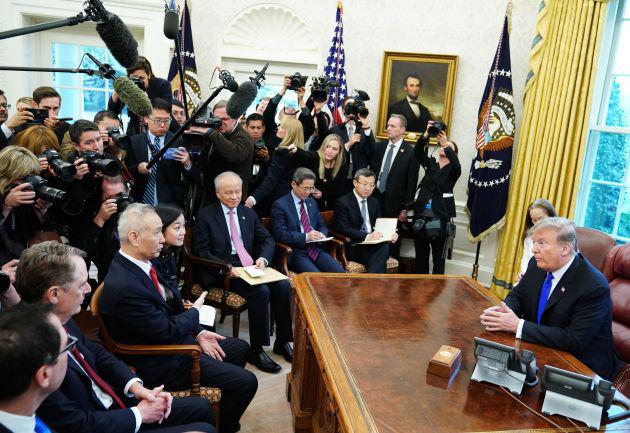
The U.S. and China appear more likely to reach a trade agreement during an expected meeting between their two presidents later this month — but some tariffs would most probably be kept in place, Goldman Sachs predicted Monday. “Our base case is that an agreement would leave some US tariffs in place, potentially lifting them in stages as various commitments under the agreement have been met. We nevertheless expect some US tariffs to remain in place into 2020,” the U.S. investment bank wrote in the report.
Goldman Sachs said that trade tensions between the two economic powerhouses appear to have “improved” over the last few weeks, with officials from both countries meeting several times and citing progress. Later, sources told CNBC that negotiations are in the “final stages.” For much of 2018, the U.S. and China were embroiled in a tit-for-tat trade fight, as they increased levies on each other’s goods over disagreements about Chinese subsidies and alleged forced technology transfers from American firms to their Chinese partners.
White House economic advisor Larry Kudlow on China trade and fourth-quarter GDP
In late February, President Donald Trump delayed plans to increase tariffs on an additional $200 billion in Chinese goods to 25 percent from 10 percent, citing “substantial progress” in the latest talks with Beijing. He said the world’s two largest economies would plan a summit to “conclude an agreement” assuming “both sides make additional progress.
That meeting with Chinese President Xi Jinping will likely take place at Trump’s resort, the Mar-a-Lago golf club in Palm Beach, Florida.
Three stages
Going forward, the process to reach a trade deal could take place in three phases, Goldman said. Most immediately, U.S. and Chinese officials are likely to continue meeting over the next few weeks to work out differences on the outstanding issues. The second phase will likely result in a Trump-Xi meeting in late March where unresolved issues are ironed out, said the investment bank. If the Florida meeting takes place, Goldman predicts there would be a 75 percent probability that the two presidents announce a formal agreement of some kind. The ongoing negotiations have included thorny issues between both countries, such as enforcing punishment for intellectual property theft, technology transfer and structural reforms related to trade and economic policies. “That said, we expect that whatever is agreed at that point will lack specifics in many areas and that additional technical work will still need to be done after the presidential meeting takes places,” it said. The third phase — which would be the most unclear in terms of outcome — is enforcement of the agreement, where the issue of tariff rates will raise some uncertainty, according to the Goldman report.
Implementation is key
U.S. Trade Representative Robert Lighthizer has said the U.S. would take “proportional and unilateral action” to enforce the terms of the deal. Goldman interpreted that to mean imposing new tariffs — or re-imposing some of them — if the U.S. believes that China is not living up to the agreement. “It is not yet clear whether tariffs will be lifted or at least reduced as part of whatever agreement Presidents Xi and Trump might reach,” the report said. “We would expect that the US would push to keep the current tariffs in effect in the near-term and reduce them only once China implements aspects of the agreement. We expect China to press for their immediate removal.” If the U.S. eventually enacts the tariffs it has threatened — raising levies from 10 percent to 25 percent on $200 billion of Chinese imports, as well as increasing levies on the remaining $267 billion of other Chinese products — that could raise $97 billion in additional tariff revenues for the U.S., Goldman calculated.
Impact on China economy
The full extent of tariffs threatened by the U.S. would cut China’s GDP by another 0.3 percent, or $36 billion, in addition to the effects of tariffs already implemented, Goldman estimated. While it’s unlikely that a 25 percent tariff on all Chinese imports will happen, policymakers in the world’s second largest economy could be willing to absorb costs of at least $10 billion annually — or even several times that “depending on how seriously they take the risk of additional tariffs,” said the bank. To do that, China could buy more from the U.S., Goldman said. Sources have separately confirmed to CNBC that China has committed to buying up to $1.2 trillion in U.S. goods. According to the report, increased purchases in several areas are on the negotiating table, and Beijing may be contemplating the following:
Agriculture: more purchases of soybean, corn and rice, to the tune of $30 billion more per year — that’s about triple the current level.
Energy: crude oil, LNG and ethanol.
Semi-conductor imports of up to $200 billion over six years.
“We expect that China would focus much of its total purchase commitment on agricultural and energy commodities,” Goldman said, adding that Beijing can then reduce purchases of those products from other suppliers, as they are “less differentiated and much easier to substitute.”